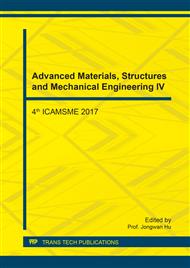p.112
p.117
p.123
p.131
p.135
p.140
p.147
p.153
p.158
Pelletization and Granulation of Calcium Oxide Powder Based on Eggshell
Abstract:
The objective in this study focuses oncalcium oxide pellets and granules preparation made from hen eggshellmixed with polysaccharides acted as a binder by wet process. There are many factors effect to size and shape of pellets and granules i.e. types, amount, particle size of binders, viscosityof mixture, and temperature of liquid medium. An important factor is types of binder effect to particle design, nuclei formation, solid-liquid interaction, amount and size of porosity, and pellets/granules dispersion.In this study, all-purpose flour is one kind of polysaccharides and organic binders which is the most suitable for calcium oxide pellets and granules preparation. The average particle, viscosity, amount of starch content of all-purpose flour are equal to 35.9 µm, 1,864 ± 8 cp, 115 ± 1 RVU including non-toxic and less expensive.Furthermore, the chemical composition, particle size, viscosity, and chemical functional groups were measured by using XRF, particle size analyzer, viscometer, and FTIR, and are reported here.
Info:
Periodical:
Pages:
135-139
Citation:
Online since:
November 2017
Authors:
Keywords:
Price:
Сopyright:
© 2017 Trans Tech Publications Ltd. All Rights Reserved
Share:
Citation:


